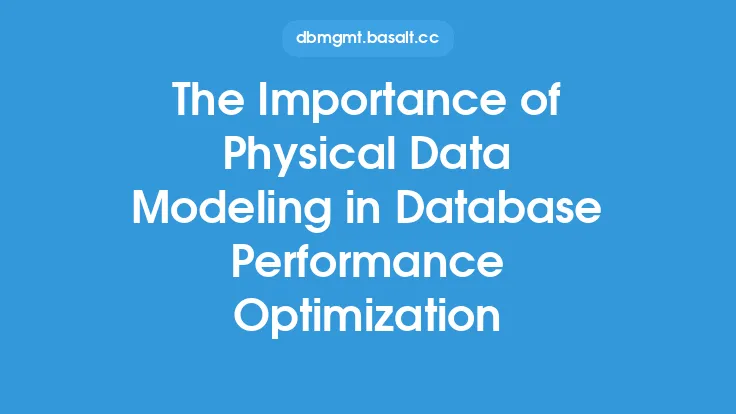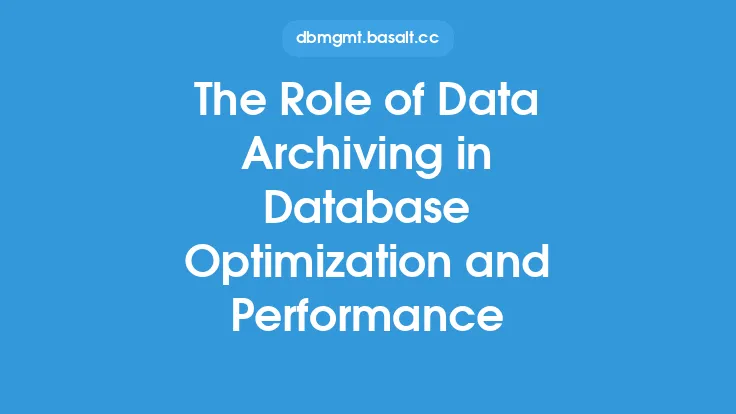When it comes to optimizing database performance, there are several factors to consider, including hardware, software, and configuration. However, one crucial aspect that is often overlooked is data modeling. Data modeling plays a vital role in database performance optimization, as it directly affects how data is stored, retrieved, and manipulated. In this article, we will delve into the world of data modeling and explore its significance in optimizing database performance.
Introduction to Data Modeling
Data modeling is the process of creating a conceptual representation of data, which includes entities, attributes, and relationships. It involves identifying the key elements of the data, their relationships, and the rules that govern them. A well-designed data model is essential for building a robust and scalable database that can support the needs of an application or organization. Data modeling involves several principles, including data normalization, denormalization, and entity-relationship modeling, which will be discussed later in this article.
The Impact of Data Modeling on Database Performance
Data modeling has a significant impact on database performance, as it affects how data is stored, retrieved, and manipulated. A poorly designed data model can lead to performance issues, such as slow query execution, data redundancy, and data inconsistencies. On the other hand, a well-designed data model can improve database performance by reducing data redundancy, improving data integrity, and enhancing query execution. For instance, a data model that uses normalization principles can reduce data redundancy and improve data integrity, resulting in faster query execution and improved overall performance.
Data Normalization Principles
Data normalization is a fundamental principle of data modeling that involves organizing data into tables to minimize data redundancy and improve data integrity. Normalization involves applying a set of rules to ensure that each table has a unique set of attributes and that each attribute is dependent on the primary key. There are several normalization rules, including first normal form (1NF), second normal form (2NF), and third normal form (3NF), each of which provides a higher level of normalization. Normalization is essential for improving data integrity, reducing data redundancy, and enhancing query execution.
Denormalization Techniques
Denormalization is the process of intentionally violating normalization rules to improve database performance. Denormalization involves storing redundant data to reduce the number of joins required to retrieve data, resulting in faster query execution. However, denormalization can lead to data inconsistencies and redundancy, which can negatively impact database performance. Denormalization techniques, such as pre-aggregation and summary tables, can be used to improve database performance, but they require careful consideration and planning to avoid data inconsistencies.
Entity-Relationship Modeling Principles
Entity-relationship modeling is a data modeling technique that involves identifying entities, attributes, and relationships. Entities are objects or concepts that have attributes and relationships with other entities. Attributes are characteristics of entities, and relationships describe how entities interact with each other. Entity-relationship modeling is essential for creating a conceptual representation of data, which can be used to design a database schema. Entity-relationship modeling principles, such as cardinality and optionality, are used to define the relationships between entities and ensure data consistency.
Data Modeling for Query Optimization
Data modeling plays a crucial role in query optimization, as it affects how data is retrieved and manipulated. A well-designed data model can improve query execution by reducing the number of joins required, minimizing data redundancy, and enhancing data integrity. Data modeling techniques, such as indexing and partitioning, can be used to improve query execution, but they require careful consideration and planning to avoid negative impacts on database performance.
Best Practices for Data Modeling
To optimize database performance, it is essential to follow best practices for data modeling. These include:
- Normalizing data to minimize redundancy and improve data integrity
- Denormalizing data to improve query execution, but avoiding data inconsistencies
- Using entity-relationship modeling to create a conceptual representation of data
- Indexing and partitioning data to improve query execution
- Avoiding over-normalization, which can lead to complex queries and poor performance
- Using data modeling tools to design and optimize database schemas
Conclusion
In conclusion, data modeling plays a vital role in database performance optimization. A well-designed data model can improve database performance by reducing data redundancy, improving data integrity, and enhancing query execution. Data modeling principles, such as normalization, denormalization, and entity-relationship modeling, are essential for creating a robust and scalable database. By following best practices for data modeling, database administrators and developers can optimize database performance, improve data consistency, and support the needs of applications and organizations.





